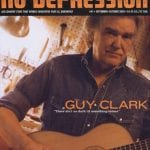Roscoe Holcomb – Stranger in a strange land
The steep ridges and narrow valleys of the Cumberland Plateau separate the coal country of eastern Kentucky from the rolling hills of the Appalachians to the south. Strip mining has leveled many of the ridges and washed rock and gravel into many of the hollers, making a tough place even tougher. Thus it has set the scene for the hard life that has often come upon the land and its people.
It is no surprise that some of our country’s most intense music has come from its most tragic places. The Mississippi delta and eastern Kentucky form an axis of poverty and passion that continues to resonate in American song.
I had just finished my first year at the University of Chicago the summer of 1960. I traveled to the town of Hamilton, in southern Ohio, to meet Harlan County (Kentucky) banjo player Pete Steele. This was a logical step for a child of the old left who grew up with the music of Woody Guthrie, Pete Seeger and Lead Belly, whose parents refused to allow balloon bread or even a television into their home.
Steele had been recorded for the Library of Congress in the late 1930s and had been an inspiration and teacher to the young Pete Seeger. Steele referred to Seeger’s then-recent run-in with the House Un-American Activities Committee with the most localized kind of language; you would have thought Seeger had been down at the county courthouse rather than in the halls of Congress.
For northern lovers of southern music, 1960 seems to have been a watershed year. The Newport Folk Festival presented Lester Flatt & Earl Scruggs, and Sam Charters’ seminal The Country Blues had just been published (in 1959). Meanwhile, I heard from a fellow student and banjo player named Manny Meyer that John Cohen of the New Lost City Ramblers had been in eastern Kentucky to record an incredibly intense banjo player and singer named Roscoe Holcomb.
I bought the Folkways album Mountain Music Of Kentucky, which featured Holcomb. “Incredibly intense” barely describes his performances of “Stingy Woman Blues”, “I Wish I Were A Single Girl Again”, and “Across The Rocky Mountains”. On the last song, he had tuned his guitar like a banjo, picked it like a banjo, and made the instrument drive and whine in a way I have never heard before or since.
In a 1968 Rolling Stone interview, Eric Clapton cited Roscoe Holcomb, a “bluegrass” musician from Kentucky, as his favorite country musician. Although Holcomb was not a bluegrass musician, Clapton had hit on a partial truth. When Mike Seeger interviewed “Lummy” Thornberry, another banjo player from the Hazard, Kentucky, area, he also described Holcomb’s music as “bluegrass,” not “old-time”; and in fact the drive of Holcomb’s performances, as well as his high pitched singing, went beyond previously recorded mountain folk music and mirrored the postwar intensity of Bill Monroe.
John Cohen coined the phrase “high lonesome sound” to describe Holcomb’s music; of course, that phrase has been appropriated to describe Monroe’s bluegrass music, and thereby completes the circle.
Cohen brought Holcomb to the first University of Chicago Folk Festival in February 1961, and the simple fact that he was invited back to other festivals and concerts speaks for his effect on the audiences.
Roscoe stayed with me for his second Chicago appearance in 1963, my first opportunity to spend time with him. I was interested in his reaction to different types of recorded old-time music, so I played him Blind Lemon Jefferson’s 1927 recording “Match Box Blues”, which Roscoe had echoed both lyrically and instrumentally on his own “Stingy Woman Blues”. “Match Box Blues”, Jefferson’s most famous song, had influenced black and white musicians throughout the south. In 1962, it still had a future as well as a past, because the Beatles would soon record it, copying Carl Perkins’ rockabilly version.
Roscoe’s comment about Jefferson’s recording, beyond his evident admiration, was simply that musicians back then did not have “good ringing guitars.”
Then I played him a recording by the Alabama Sacred Harp Singers from Harry Smith’s Anthology Of American Folk Music. Sacred harp music, a form of southern church music with interweaving polyphonic lines, was distinctly different from the religious music of Roscoe’s eastern Kentucky, where modal unison a cappella lining hymns were starkly monophonic. The best way to imagine a modal lining hymn would be to take “Man Of Constant Sorrow”, leave out the chords and rhythm, slow it down, and have it sung in unison by a whole church congregation in the high lonesome style. Roscoe had never heard sacred harp music before, and his immediate reaction was that the performance was meaningless because the words could not be understood.
Roscoe had in fact hit the nail on the head, because sacred harp music is not really meant to be listened to by an outsider. It is participatory music in which congregations have daylong singing sessions and all the singers perform from books with the words right in front of them. The lining hymns Roscoe sang came from a tradition in which there were no hymnbooks for the congregation, whose members often couldn’t read. The song leader would intone a line of the song in a recitative-like note pattern, and the congregation would follow with the full melody.
These hymns are very ancient; they originated in Scotland (many southern Appalachian settlers were Scots-Irish), and have a historical relationship to Gregorian and even earlier forms of Christian chant. I found myself drawn to them because they seemed to be the oldest and most essential distillation of mountain culture. Bill Monroe used the phrase “ancient tones” to describe the background of his music, and these hymns certainly fit that description.




